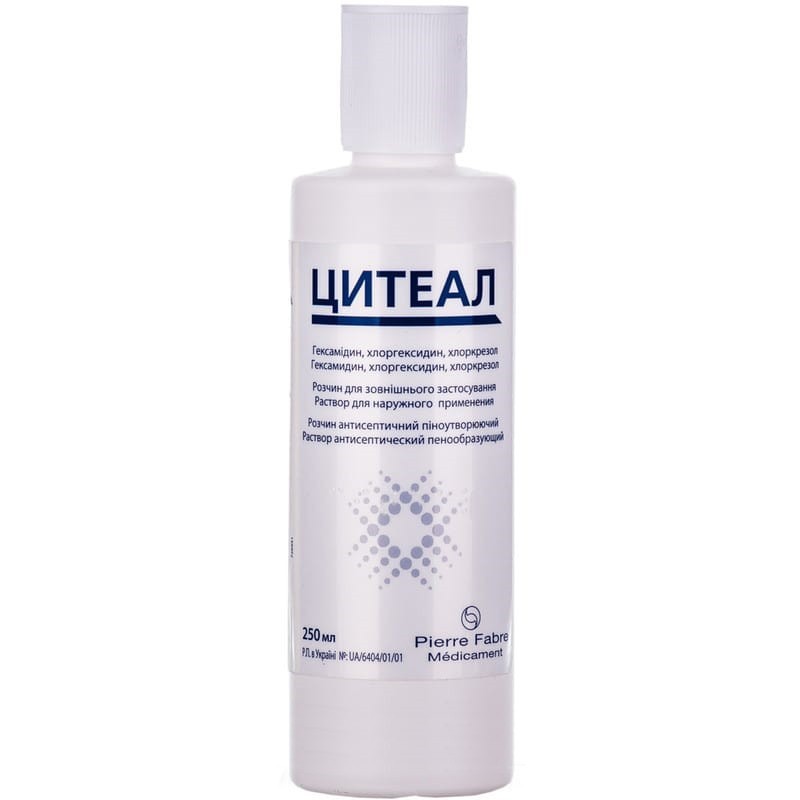



 Secure and encrypted payment processing
Secure and encrypted payment processing We ship to over 40 countries including the USA, UK, Europe, Australia and Japan
We ship to over 40 countries including the USA, UK, Europe, Australia and Japan Guaranteed refund or reship if you haven't received your order
Guaranteed refund or reship if you haven't received your orderFoaming solution designed for antiseptic treatment of the skin and mucous membranes. the composition of the drug includes chlorhexidine (cationic antiseptic group of synthetic biguanides); hexamidine (cationic antiseptic of the diamidine group); chlorocresol (antiseptic group of halogenated phenols).
The drug is a mild antiseptic with bacteriostatic (but not bactericidal), antifungal and antitrichomonadal action.
Organic materials may partially inhibit the drug. It forms complex compounds with cork, rubber and other polymers, macromolecules, anionic (soap) and nonionic surfactants.
Antiseptic treatment of the skin and mucous membranes with bacterial and fungal infections, with a tendency to develop superinfection.
Only externally. oral or parenteral administration is prohibited!
Use as a liquid soap in undiluted form or after dilution with water in a ratio of 1:10. After application of the drug, the treated area is washed with plenty of water.
The diluted solution of the drug is not subject to storage.
Hypersensitivity to hexamidine or chlorhexidine. tendency to allergic reactions and allergic diseases, dermatitis, viral skin diseases.
Cital cannot be used for:
Avoid contact of the drug with the meninges.
The drug is not used locally in ophthalmic practice, as well as for processing the external auditory canal, if there is perforation of the eardrum.
Local reactions: pain, itching, burning, irritation, dry skin, skin hyperemia, stickiness of the skin of the hands, photosensitivity, especially with repeated use.
Local reactions of hypersensitivity to chlorhexidine, such as contact dermatitis, urticaria, contact eczema, may occur; as well as anaphylactic shock, angioedema, bronchospasm (especially when treating damaged skin and mucous membranes or ulcers of the lower extremities). These reactions can exacerbate superinfection lesions.
When applied to damaged skin or mucous membranes, there is a risk of a generalized allergic reaction to chlorhexidine and the development of anaphylactic shock, bronchospasm, urticaria, hypotension, tachycardia, collapse, angina pectoris.
Hexamidine can cause sensitization, the likelihood of which increases with increasing severity of epidermal lesions. Contact dermatitis caused by hexamidine is associated with a specific Arthus reaction, which may indicate the participation of humoral immunological mechanisms. Clinical symptoms in such cases are generally different from classical contact eczema: a rash usually with infiltrates, papular or papulo-vesicular hemispherical elements of the rash, isolated or grouped, are observed. In places of application of an antiseptic there are more of them and they can merge. Often such lesions slowly regress.
Given the lack of information on transdermal absorption, the appearance of systemic effects cannot be ruled out. the likelihood of their occurrence increases with repeated applications, especially when a large area is treated, the surface under an occlusive dressing or mucous membranes, if there are injuries on the skin (including burns),as well as in the case of treatment of the skin of newborns (taking into account the ratio of the surface area and body weight of the child, as well as the occlusive effect of diapers).
After opening the bottle, there is a risk of microbial contamination of the drug.
As with any detergent, the treated area must be thoroughly rinsed with water.
Note. Antiseptic agents are not sterilizing. They only temporarily reduce the number of microorganisms.
Use during pregnancy and lactation. The drug is used during pregnancy and lactation only in cases where the expected positive effect for the mother outweighs the potential risk to the fetus / child.
Influence on the ability to drive vehicles and work with complex mechanisms. Does not affect.
Children. Citeal can be used for antiseptic treatment of the skin of children, including infants.
Given the possibility of interaction (antagonism, inactivation), simultaneous or sequential use of cytal with other antiseptics to treat the surface of the skin should be avoided.
Concurrent use with soap should be avoided. Do not clog the bottle with a cork product.
The drug increases the sensitivity of bacteria to chloramphenicol, kanamycin sulfate, neomycin sulfate, cephalosporins. Incompatible with iodine preparations due to the risk of dermatitis, with soap and other anionic compounds (colloids, gum arabic, carboxymethyl cellulose). Ethanol enhances the effect of the drug.
Chlorhexidine is incompatible with borates, carbonates, chlorides, citrates, phosphates, sulfates, since insoluble compounds are formed.
No cases of overdose with external use of cytal have been reported. with local application in large quantities or with prolonged contact, skin irritation, dryness and itching of the skin, dermatitis and other manifestations of adverse reactions are possible. in such cases, rinse the solution thoroughly with water.
Accidental ingestion can cause nausea and vomiting, shortness of breath, cyanosis due to paralysis of the respiratory muscles, which can lead to asphyxiation. Possible depression of the central nervous system, accompanied by convulsions, hypertension, a coma may occur, cases of death with signs of hepatic-renal failure are described.
In case of accidental use of Citeal, the stomach should not be washed inside, since the drug is foaming.
In a dark place at a temperature of no higher than 25 ° C.